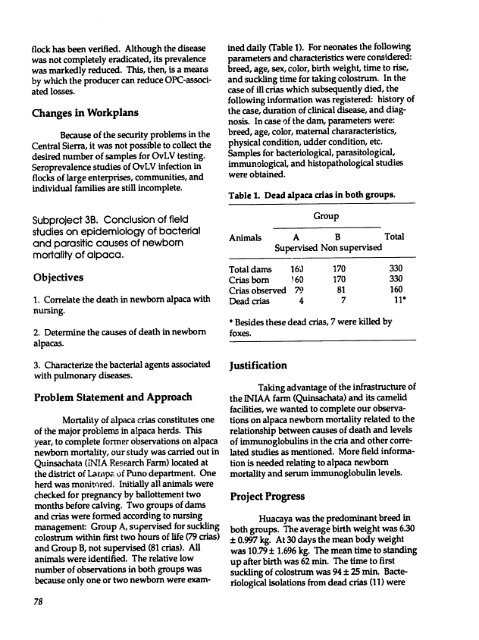Research Results - (PDF, 101 mb) - USAID
Research Results - (PDF, 101 mb) - USAID
Research Results - (PDF, 101 mb) - USAID
You also want an ePaper? Increase the reach of your titles
YUMPU automatically turns print PDFs into web optimized ePapers that Google loves.
flock has been verified. Although the disease<br />
was not completely eradicated, its prevalence<br />
was markedly reduced. This, then, is a means<br />
by which the producer can reduce OPC-associated<br />
losses,<br />
Changes in Workplans<br />
Because of the security problems in the<br />
Central Sierra, it was not possible to collect the<br />
desired nu<strong>mb</strong>er of samples for OvLV testing.<br />
Seroprevalence studies of OvLV infection in<br />
flocks of large enterprises, communities, and<br />
individual families are still incomplete.<br />
Subproject 3B. Conclusion of field<br />
studies on epidemiology of bacterial<br />
and parasitic causes of newborn<br />
mortality of alpaca.<br />
Objectives<br />
1. Correlate the death in newborn alpaca with<br />
nursing.<br />
2. Determine the causes of death in newborn<br />
alpacas.<br />
3. Characterize the bacterial agents associated<br />
with pulmonary diseases.<br />
Problem Statement and Approach<br />
Mortality of alpaca crias constitutes one<br />
of the major problems in alpaca herds. This<br />
year, to complete former observations on alpaca<br />
newborn mortality, our study was carried out in<br />
Quinsachata (INIA <strong>Research</strong> Farm) located at<br />
the district of Lampa of Puno department. One<br />
herd was monitored. Initially all animals were<br />
checked for pregnancy by ballottement two<br />
months before calving. Two groups of dams<br />
and crias were formed according to nursing<br />
management- Group A, supervised for suckling<br />
colostrum within first two hours of life (79 crias)<br />
and Group B, not supervised (81 crias). All<br />
animals were identified. The relative low<br />
nu<strong>mb</strong>er of observations in both groups was<br />
because only one or two newborn were exam-<br />
78<br />
ined daily (Table 1). For neonates the following<br />
parameters and characteristics were considered:<br />
breed, age, sex, color, birth weight, time to rise,<br />
and suckling time for taking colostrum. In the<br />
case of ill crias which subsequently died, the<br />
following information was registered: history of<br />
the case, duration of clinical disease, and diagnosis.<br />
In case of the dam, parameters were:<br />
breed, age, color, maternal chararacteristics,<br />
physical condition, udder condition, etc.<br />
Samples for bacteriological, parasitological,<br />
immunological, and histopathological studies<br />
were obtained.<br />
Table 1. Dead alpaca crias in both groups.<br />
Group<br />
Animals A B<br />
Supervised Non supervised<br />
Supervised Nonsupervised<br />
Total dams 160 170 330<br />
Crias born '60 170 330<br />
Crias observed 79 81 160<br />
Dead crias 4 7 11*<br />
* Besides these dead crias, 7 were killed by<br />
foxes.<br />
Justification<br />
Taking advantage of the infrastructure of<br />
the INIAA farm (Quinsachata) and its camelid<br />
facilities, we wanted to complete our observations<br />
on alpaca newborn mortality related to the<br />
relationship between causes of death and levels<br />
of immunoglobulins in the cria and other correlated<br />
studies as mentioned. More field information<br />
is needed relating to alpaca newborn<br />
mortality and serum immunoglobulin levels.<br />
Project Progress<br />
Huacaya was the predominant breed in<br />
both groups. The average birth weight was 6.30<br />
± 0.997 kg. At 30 days the mean body weight<br />
was 10.79 ± 1.696 kg. The mean time to standing<br />
up after birth was 62 min. The time to first<br />
suckling of colostrum was 94 ± 25 min. Bacteriological<br />
isolations from dead crias (11) were

















